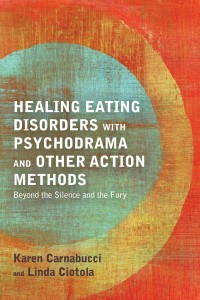JKP author Linda Ciotola, M.Ed., TEP, co-author with Karen Carnabucci of Healing Eating Disorders With Psychodrama and Other Action Methods – Beyond the Silence and the Fury, discusses American culture and its impact on eating disorders in women.
“Anorexia is both the result of a protest against the cultural rule that your women must be beautiful. In the beginning, a young woman strives to be thin and beautiful, but after a time, anorexia takes on a life of its own. By her behavior, an anorexic girl tells the world, ‘Look, see how thin I am, even thinner than you wanted me to be. You can’t make me eat more. I am in control of my fate, even if my fate is starving.’” – Mary Pipher, “Reviving Ophelia”
Many people believe that the young woman who suffers anorexia epitomizes our culture’s definition of what it means to be feminine: thin,  passive, and eager to please. The metaphor is that she will become what our culture asks of its women: to become non-threatening, taking up little space while being decorative and not intimidating and non threatening.
passive, and eager to please. The metaphor is that she will become what our culture asks of its women: to become non-threatening, taking up little space while being decorative and not intimidating and non threatening.
Beauty is a defining characteristic for women. Girls worry about clothes, makeup, skin and hair – but mostly about weight. In our book, Healing Eating Disorders with Psychodrama and Other Action Methods: Beyond the Silence and the Fury with co-author Karen Carnabucci – we talk about how this societal standard for beauty influences our image of ourselves and is one of the many contributors to the rise of eating disorders and chronic dieting struggles with girls and women. Sadly enough this emphasis on appearance is quickly spreading to boys and men as well – and eating and body disorders are growing with them as well as we discuss in our book along with specific interventions for these populations.
Why is appearance so important?
We have moved from communities of primary relationships in which people know each other to communities of secondary relationships where appearance is the only dimension available for the rapid assessment of others.
Today’s media portrays desirable women as thin. In 1950, models averaged five feet, four inches in height and weighed 140 pounds. Today, the standard is five feet, ten inches and 110 pounds!
A recent study found that 11 percent of people in the United States would abort a fetus if they were told it would grow into a child that would have a tendency toward obesity. Elementary school children have more negative attitudes toward obese children than toward bullies. Obese students are less likely to be granted scholarships. Being fat means being left out, scorned, vilified, and often bullied.
In order to help our young people value their true selves and grow into healthy adults, we recommend the need for love from family and friends, meaningful work, respect, challenges and physical and psychological safety. They need identities based on character, talent, interests instead of appearance, popularity and sexuality. Instead of scales and diets, we do better to promote healthful meals, family exercise, and a value system that de-emphasizes the importance of looks.
Psychodrama and related action methods, through role play and other explorative tools, provide an important route to discovering how to find and sustain these connections and identities in their lives. These methods can be used in education and in community settings as well as in therapy.
As a psychodramatist and psychodrama trainer, I often ask my clients:
“If you were living on a magical island where weight, size, shape, appearance had no value and, instead were neutral, what would you find yourself focusing on?”
This question is a perfect question to think about – and, better yet, to act out in the psychodrama room. With these actions, we can experientially discover another reality, one that is healthy – and through the power of action methods old roles based upon body obsession can be transformed into new roles based upon character.